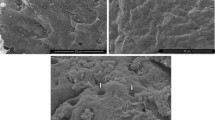Summary
Serratia marcescens andSarcina lutea could not be recovered from the feces of animals into whose colon they were injected through a cecal fistula. This finding was the same whether the intestinal flora of the experimental animals was high or low in itsL. acidophilus content.
B. mycoides could be recovered from the feces of dogs as late as 72 hours after injection; when vegetative cells were injected, only vegetative cells were recovered; whereas, when spores were introduced, spores were recovered. These findings were apparently independent of the status of the animals’ natural intestinal flora.
Similar content being viewed by others
Author information
Authors and Affiliations
Additional information
Department of Bacteriology, Yale University.
Rights and permissions
About this article
Cite this article
Weinstein, L. The fate of bacteria injected directly into the cecal end of the colon. American Journal of Digestive Diseases and Nutrition 3, 397–398 (1936). https://doi.org/10.1007/BF02999159
Received:
Issue Date:
DOI: https://doi.org/10.1007/BF02999159




